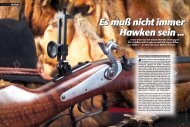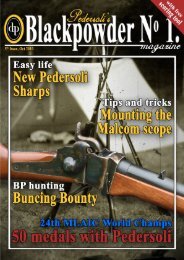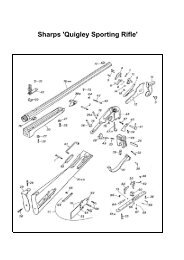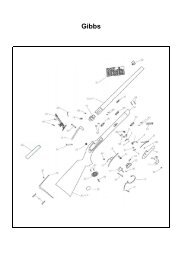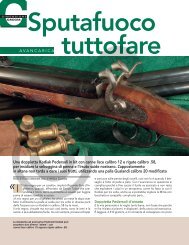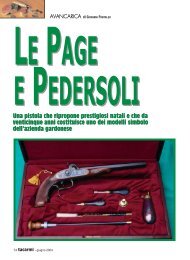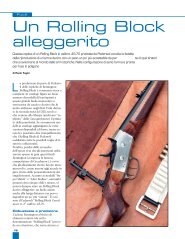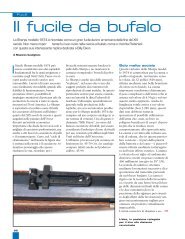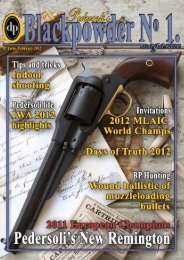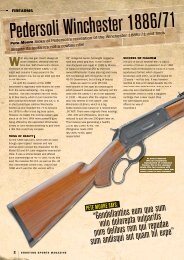You also want an ePaper? Increase the reach of your titles
YUMPU automatically turns print PDFs into web optimized ePapers that Google loves.
<strong>In</strong> <strong>this</strong> <strong>issue</strong><br />
Tips and tricks:<br />
The quick flintlock ignition<br />
Loading the DP 1857 rifle<br />
The secret of 38-55<br />
From the shooting stands:<br />
13th MLAIC EC in Valencia<br />
<strong>In</strong>ternational matches in 2010<br />
Euroliga 2009<br />
Dear Shooters, Collectors, enthusiasts of firearms history all over the<br />
World,<br />
It has been a long time since our company accepted the challenge to<br />
make the finest and most accurate replicas of historical firearms for<br />
precision target competitors, hunters, cowboy action shooters, collectors<br />
and enthusiasts of military history. <strong>In</strong> the past 50 years we have always<br />
paid great attention to the words of the shooters, as primarily they were<br />
the ones who could help us improve continuously.<br />
Now we would like to move <strong>this</strong> conversation to a higher level. We would<br />
like to share the extensive knowledge and experience gathered in the<br />
past five decades with the wide audience of shooters all around the<br />
World.<br />
Our firearms broke many records in international muzzle-loading or<br />
black powder cartridge competitions. For a medal winning score the<br />
best firearm is essential, but still not enough. The shooter must also<br />
equip himself with the knowledge of many important fields of shooting.<br />
He has to understand the internal and external ballistics of the rifle he<br />
uses. He has to know how to hold the rifle, the techniques which do not<br />
obstruct the operation of the barrel. He has to understand completely the<br />
functioning of the rifle to be able to adjust it properly to his needs. Last<br />
but not least: without knowing the historical background of the gun, he<br />
will never ever have the close relationship with it that is necessary for<br />
working together in harmony on the firing line.<br />
Our quarterly Blackpowder No. 1. magazine is intended to spread <strong>this</strong><br />
knowledge to target shooters, hunters, collectors, western shooters,<br />
skirmishers, re-enactors all around the World. We would like to help the<br />
work of the international shooting federations as well by publishing<br />
articles relating to significant matches, international events, exceptional<br />
achievements, rule changes, etc...<br />
Best regards,<br />
Pierangelo <strong>Pedersoli</strong>, Balázs Németh<br />
What's new?<br />
<strong>Pedersoli</strong>'s 2009 products<br />
Long Range Shooting<br />
<strong>In</strong> the footsteps of John Bodin<br />
<strong>Pedersoli</strong> pages<br />
Useful links<br />
Collectors' Corner<br />
The Boutet Officer pistol
<strong>In</strong> September 2009 nearly 300<br />
blackpowder shooters gathered from<br />
all over Europe to Valencia, to<br />
challenge each other in a noble contest<br />
to decide who is the best in Europe in<br />
muzzleloading individual and team<br />
competitions.<br />
The numbers<br />
Altogether 17 countries entered teams<br />
in the championships <strong>this</strong> year. <strong>In</strong> the<br />
four days of the championships the<br />
shooters entered the shooting lines<br />
1345 times. The top scoring nations of<br />
the competition were Germany, France,<br />
and Spain, the hosting nation. 16 new<br />
record scores were shot, which<br />
indicates the high quality standards of<br />
the event. It was in Valencia that 2 new<br />
individual matches (Malson and<br />
Remington) and 2 new team events<br />
(Egg, Enfield) were held for the first<br />
time as part of the normal shooting<br />
program.<br />
The opening ceremonies<br />
The opening ceremonies took place at<br />
a small marina close to Valencia. The<br />
organizing committee however did not<br />
<strong>Pedersoli</strong> 1857 Württembergischen - new ER in Lamarmora with 98
pay too much attention to starting the ceremonies<br />
punctually, so the delegations had to wait nearly<br />
two and a half hours under the hot Spanish sun<br />
on the beach. This is not such a great problem if<br />
you have a cold beer in your hand, and your only<br />
job is to lie in the sand and cool in the sea, but<br />
before a competitive event it is not really<br />
an advantageous start.<br />
Re-enactment on the beach<br />
The opening ceremony itself was fabulous. It<br />
started with a short speech from the local<br />
principals followed by the welcoming speech by<br />
Mr. David Bridgen, secretary general of MLAIC.<br />
The main attraction of the ceremonies was a<br />
spectacular re-enacting of medieval<br />
jousting, and the recreation of a<br />
Napoleonic battle between Spanish<br />
and French forces. The loudest<br />
participant of the game was a 12<br />
pounder smooth bore cannon which<br />
was defended by the Spanish infantry<br />
against the French line infantry and<br />
light cavalry. The last shot of the<br />
cannon signaled the official start of<br />
the competition.<br />
The range<br />
The shooting range was located in<br />
Naquera, a few kilometers from<br />
Valencia. The newly<br />
renovated Olympic shooting<br />
range had more than enough<br />
shooting stands at 25, 50 and<br />
100 m to secure a flawless<br />
competition. The clay target<br />
range was located in a small<br />
village near west from<br />
Valencia, nearly 40 kms from<br />
Naquera, but only 30 minutes<br />
away by car. However it was<br />
not easy for the competitors<br />
shooting both clay target and<br />
precision events...<br />
The organizing<br />
committee<br />
The principal organizer of the<br />
championship was the Real<br />
Federación Espanola de Tiro Olímpico (Spanish<br />
Royal Olympic Shooting Society). Many Spanish<br />
officials, range officers and helpers worked<br />
together a whole week to manage the challenges<br />
of a great international event under the<br />
supervision of the Spanish MLAIC delegate, Mr.<br />
Jose Luis Perez-Pastor. MLAIC held its annual<br />
delegates' meeting at the championship as well.<br />
The Finnish and Polish team presented their<br />
application for the 2011 European<br />
Championships, and with close results Finland<br />
won the possibility right to hold the 14th<br />
European Championships. The delegates' meeting<br />
also started preparation for their next - worldwide<br />
- meeting in Portugal next year, where the most<br />
important rule changes will be decided.
National teams, competitions<br />
The biggest team was entered by the organizing<br />
country Spain. Austria and Germany were second<br />
and third on the list with regard to the number of<br />
shooters. The most successful team was Germany,<br />
followed by France and Spain. The most popular<br />
events were Mariette (with 118 shooters)<br />
followed by Colt, Malson and Remington -<br />
which is proof that percussion revolvers are still<br />
one of the main driving forces behind muzzle<br />
loading shooting sports.<br />
Results<br />
Seven new European records were set in<br />
individual events, while another nine in team<br />
events. We also have to mention five other scores<br />
which equaled the current European record.<br />
These great achievements show the extremely<br />
high overall level of the competition: only top<br />
shooters, in top mental and physical fitness with<br />
top quality firearms can reach medal winning<br />
scores and the the winners’ stand.<br />
BPNo1<br />
Click<br />
for the results!<br />
<strong>Pedersoli</strong> 1766 Charleville - new ER in Miquelet R with 97
The national<br />
teams of seventeen<br />
European countries<br />
gathered in two small<br />
villages near Valencia,<br />
in Naquera (precision<br />
shooting) and Cheste<br />
(clay target shooting)<br />
to attend the 13th<br />
MLAIC European<br />
Championships from<br />
7 – 12th September,<br />
2009.<br />
<strong>Davide</strong> <strong>Pedersoli</strong> always paid a great deal<br />
of attention to all international shooting matches<br />
promoting muzzle loading shooting. It is like<br />
standing behind the shooters using our arms on<br />
the shooting lines as well, sharing the stress and<br />
glory of their success. Every success arouses<br />
strong emotions and great satisfaction among our<br />
company crew, sharing the positive thoughts of<br />
the champion shooters stepping up to the stands<br />
of the award ceremonies. Winning an important<br />
medal in any discipline is also a great<br />
acknowledgement for the company which<br />
constructed the champion's firearm. It is an<br />
acknowledgement for the scrupulous way these<br />
guns are manufactured in Gardone Val Trompia,<br />
with modern technologies and respect to the<br />
many centuries old traditions and experience of<br />
master gunsmiths of <strong>this</strong> area.<br />
The European Championships in<br />
Valencia enriched the <strong>Pedersoli</strong> Hall of Fame<br />
with 35 new medals in different categories,<br />
achieving more gold, silver and bronze results<br />
than in Parma 2007. The number of gold medals<br />
increased from 9 to 15, the number of silver<br />
medals stayed at the same level with 10 second<br />
places, only the number of bronze medals<br />
dropped from 14 to 10.<br />
Congratulations to all the shooters of<br />
<strong>Pedersoli</strong> g<br />
individual and team events, especially to those<br />
who trusted, selected and used a <strong>Pedersoli</strong><br />
produced gun to reach theirmedallist results.<br />
The individual gold medals with<br />
<strong>Pedersoli</strong> arms were won by the following:<br />
Pascal Manchin from France won in Cominazzo<br />
with a Le Page flintlock pistol, Timo Näätänen -<br />
Lihavainen from Finland won the Miquelet event<br />
with a Mod An IX musket with the new<br />
European record of 97. Jose Ramon Galan<br />
Talens of Spain shooting the Württenbergischen<br />
rifle won the gold medal in Lamarmora with the<br />
new European record score of 98. Giuliana<br />
Casucci from Italy was victorious in the Walkyre<br />
event with her Tryon Creedmoor rifle. Franz<br />
Lotspeich from Germany won both Lorenzoni<br />
(with a score of 49, a new European record) and<br />
Manton events with his Mortimer shotguns.<br />
The other gold medals were won in team<br />
events: Leopold Plattner from Austria helped his<br />
team to a gold in Forsyth with his Le Page pistol.<br />
The Finnish flintlock musket team achieved a<br />
new European record with 276, with Timo<br />
NäätänenLihavainen and Antero Mustamäki<br />
shooting the An IX musket. The Pforzheim event<br />
was won by the French team, with Herve<br />
Amann and Jean-Luc Mainchin shooting<br />
<strong>Pedersoli</strong> Bristlen Morges rifles. Germany<br />
succeeded in Enfield, Amazons and Lucca, with<br />
Josef Mayr shooting a Württembergischen rifle,<br />
Rita Palmer using a Gibbs and Alfred Bailer<br />
shooting the Mortimer flintlock rifle. The<br />
Spanish Magenta team won with ascore of 272<br />
(new ER) with Matias Mayol Colom and<br />
Antonio Vicente Llorca Lozano shooting their<br />
Württembergischen rifles. The German team<br />
also won the Hawker and Batesville events with<br />
Roland Robben and Franz Lotspeich shooting<br />
Mortimer shotguns.<br />
The individual silver medals were won<br />
by the following shooters: from Austria Herbert<br />
Wagner won the silver medal in Cominazzo with<br />
a Le Page pistol, while Andreas Handl shot a<br />
second place in Maximilian with his Jager rifle.<br />
Joseph Mayer from Germany won the silver<br />
medal in Miquelet with a Charleville musket.<br />
The other seven medals were won in team<br />
events: Jean-Paul Pastouret (France) won the
uns on the firing line<br />
silver medal in Wogdon with a Le Page<br />
flintlock pistol, and Pascal Mainchin (France)<br />
won second place in Forsyth, with a<br />
Kuchenreuter pistol. <strong>In</strong> the German team of<br />
Halikko and Magenta all the three shooters<br />
used Pederolsi guns: Peter Käpernick, Axel<br />
Klingman and Josef Mayr in Halikko and<br />
Alfred Bailer, Josef Mayr and Axel Klingmann<br />
in Magenta (1777 and Springfield 1795<br />
muskets in Halikko and Württembergischen<br />
rifles in Magenta). The Austrian team of<br />
Pforzheim, with Andreas Gassner and Andreas<br />
Handl competed with Bristlen Morges rifles. <strong>In</strong><br />
Amazons the Spanish team won silver with<br />
Pascui Munoz Hernandez shooting a Tryon<br />
Creedmoor rifle and Yolanda Pons Martinez<br />
with a Gibbs rifle. The Italian clay shooting<br />
team with Moreno Boni and Enrico Siclari in<br />
Batesville event used the Mortimer shotguns.<br />
<strong>In</strong>dividual bronze medals were won in<br />
the following disciplines: Peter Käpernick<br />
shooting a Mod. An IX musket won bronze in<br />
Miquelet. Alfred Bailer in Lamarmora and<br />
Josef Mayr in Minié won bronze using a<br />
Württenbergischen rifle. Maeva Moelo from<br />
France won third place in Vetterli Youth with a<br />
Tryon Creedmoor rifle. Yolanda Pons Martinez<br />
from Spain achieved bronze in Maximilian with<br />
his Jäger rifle. Moreno Boni from Italy won<br />
bronze with his Mortimer shotgun in Lorenzoni.<br />
Another four team bronze medals were<br />
also won: the Swiss team in Halikko with<br />
Katherina Stierli shooting an An IX musket<br />
won third place. The same position was<br />
achieved by the German team in Pforzheim,<br />
with Walter massing shooting a Bristlen<br />
Morges rifle. Roland Thomes from France<br />
scored bronze for his team in Lucca with an<br />
Alamo rifle. Jose Ramon Galan Talens and<br />
Luciano Porta Gran used the<br />
Württenbergischen rifles at the Enfield event.<br />
We also have to add five fourth places,<br />
eight fifth places and eight sixth places to the<br />
list of 35 medals.<br />
The success of <strong>Pedersoli</strong> arms brought<br />
attention to many prestigious weapons of the<br />
<strong>Pedersoli</strong> House: the flintlock Le Page pistol,<br />
Bristlen Morges rifle, and Tryon Creedmoor<br />
rifle won three medals each. The Mortimer in<br />
various configurations and the Württenbergischen<br />
rifle won seven medals. An IX, Charleville and<br />
Springfield 1795 won seven medals also. The<br />
Jager and Gibbs rifle score two, and the Alamo<br />
flintlock, Kuchenreuter and Le Page percussion<br />
achieved one medal.<br />
Three new individual European records<br />
were shot with <strong>Pedersoli</strong> guns (Miquelet,<br />
Lorenzoni, Lamarmora) and three in team events<br />
(Halikko, Enfield, Magenta), they complete the<br />
satisfactory picture of the performances of the<br />
<strong>Pedersoli</strong> firearms in Spain.<br />
Seeing such exceptional achievements,<br />
<strong>Pedersoli</strong> congratulates all shooters who trusted<br />
and selected our arms to compete in one of the<br />
greatest muzzle loading challenges of the World.<br />
We wish our competitors all the greatest<br />
successes in the future. .<br />
More info about our products: <strong>Davide</strong> <strong>Pedersoli</strong><br />
& C., via Artigiani 57, 25063 Gardone Val<br />
Trompia; www.davidepedersoli.com<br />
(info@davidepedersoli.co<br />
m); tel. 030.8915000; fax<br />
030.8911019<br />
For more info:
It was never ever easy to be a Central-European<br />
citizen. For thousands of years <strong>this</strong> part of Europe<br />
was the battlefield of eastern and western empires,<br />
always routed by advancing or withdrawing<br />
armies. But in between east and west there are<br />
some small but proud nations with thousands of<br />
years of glorious, and sometimes bloody history.<br />
All of these small nations have their own unique<br />
culture. They all learned how to survive the fall of<br />
great empires, and they all fought their fierce<br />
rebellions against dictatorships for their well<br />
earned freedom. Hungary, Slovakia and the Czech<br />
Republic are very different countries, but<br />
somehow the people resemble each other. Even if<br />
politicians sometimes try to build walls on the<br />
borders, these people always have the will break<br />
them down. Nowadays one of the tools in <strong>this</strong><br />
fight is the smoke of blackpowder<br />
2009 was the 4th year since the Muzzleloader<br />
Associations of each country teamed up to<br />
organize a series of international matches to build<br />
2009<br />
Euroleague,<br />
4th Central-<br />
European<br />
Championships<br />
When politics fail,<br />
sportsmen come to the rescue...<br />
friendships, and of course to decide who is the<br />
best shooter in the most important muzzeloading<br />
disciplines. The Euroliga (European League?)<br />
consists of 6 + 1 matches: 2 in Hungary, 2 in<br />
Czech Republic, 2 in Slovakia and the final in<br />
Komárno.<br />
The town of Komárno or Komárom, as it is called<br />
Pennsylvania
Kuchenreuter<br />
Vetterli<br />
Cominazzo<br />
in Hungary is a very special place. It is situated on<br />
the two banks of the Danube, connected by a<br />
beautiful bridge. The southern part is in Hungary,<br />
while the northern part is in Slovakia. History<br />
divided the city and families, but they are<br />
reconnected now by cultural life and international<br />
sport events. Many nationalities lived together in<br />
peace in past centuries here, so there has never<br />
been a better place to make a friendship match in<br />
central Europe.<br />
The championship is held in 6 categories:<br />
Kuchenreuter, Mariette, Tanzutsu, Cominazzo,<br />
Vetterli, and Pennsylvania. It is not an easy job to<br />
get close to the medal winning places, as usually<br />
the scores of individual matches are close to the<br />
scores of European, and World Championships.<br />
<strong>In</strong> the Vetterli event for example, Jurza Vladimir<br />
(SVK) won the aggregate match with a score of<br />
298. He shot one 100, and 99s during the year.<br />
The second, Balázs Németh (HUN) followed him<br />
closely with 295 points (one 100, one 99, and one<br />
96). The same goes for Kuchenreuter, Mariette<br />
and Pennsylvania. The shooter needs to score<br />
constantly near the highest international levels to<br />
get close tothe medals. This is why Euroliga is<br />
the best training for the MLAIC European and<br />
World Championships.<br />
Vetterli<br />
1. Jurza Vladimir (SVK) 298 (100, 99, 99)<br />
2. Balázs Németh (HUN) 295 (100, 99, 96)<br />
3. Gyula Mészáros (HUN) 293 (100, 97, 96)<br />
Kuchenreuter<br />
1. Ernst Stefan (SVK) 291 (98, 97, 96)<br />
2. Kostolník Pavel (SVK) 289 (98, 97, 94)<br />
3. Harnis Pavol (SVK) 289 (97, 96, 96)<br />
Mariette<br />
1. Ernst Stefan (SVK) 285 (98, 94, 93)<br />
2. Hanulík Marcel (SVK) 284 (96, 95, 93)<br />
3. Kostolník Pavel (SVK) 280 (95, 95, 90)<br />
Tanzutsu<br />
1. Hanulík Marcel (SVK) 263 (91, 87, 85)<br />
2. Ernst Stefan (SVK) 261 (87, 87, 87)<br />
3. Kurza Vladimir (SVK) 257 (91, 83, 83)<br />
Pennsylvania<br />
1. Balázs Németh (HUN) 286 (99, 94, 93)<br />
2. Gyula Mészáros (HUN) 282 (96, 93, 93)<br />
3. Mihály Tar (HUN) 273 (95, 93, 85)<br />
Cominazzo<br />
1. Kostál Ladislav (SVK) 246 (86, 85, 76)<br />
2. Svetlík Jan (SVK) 189 (76, 73, 40)<br />
3 Ernst Stefan (SVK) 178 (92, 86)<br />
BPNo1
Reloading the<br />
38-55<br />
for <strong>Pedersoli</strong><br />
High Wall rifles<br />
The <strong>Pedersoli</strong> High Wall rifle 38-55 chamber has<br />
a diameter at the case neck region of 0.3990".<br />
The cases available from the many case<br />
manufacturers vary in the wall thickness of the<br />
case neck. <strong>In</strong> order to have a firm fit of the bullet<br />
into the case mouth and also to provide about<br />
.0015"- .0020" for the important case to chamber<br />
wall clearance in the neck region, the reloader<br />
must know the actual wall thickness at the case<br />
neck as well as the actual diameter of the<br />
chamber wall around the case neck region.<br />
Starline and Federal brand cases usually have a<br />
thicker wall thickness than do Remington and<br />
Winchester cases. At <strong>this</strong> time, ONLY Starline<br />
makes cases with the longer length (2.125"-<br />
2.130") to fit the <strong>Pedersoli</strong> chamber length<br />
properly for the case (2.130").<br />
Best accuracy is obtained when cases are trimmed<br />
to be as close as possible to the actual length of<br />
the case chamber (2.130"). Because new cases<br />
will stretch when fired and reloaded repeatedly, it<br />
is vital that the reloader check NEW cases for<br />
length after every firing, until no further<br />
stretching is observed. Even then, careful<br />
by Dick Trenk<br />
measurements should be made after every 4th<br />
firing of the cases and accurate trimming<br />
performed to maintain the exact overall case<br />
length to suit your own rifle's chamber<br />
dimensions. If case cleaning procedures leave the<br />
interior of the case neck somewhat dirty, such<br />
cases will tend to stretch much more then cases<br />
where the necks which have been completely<br />
cleaned by the tumbling or vibrating process.<br />
The original 38-55 calibre cartridge used a 2.130"<br />
length chamber which for technical reasons was<br />
soon shortened to cure feeding problems in some<br />
early lever action rifles. The <strong>Pedersoli</strong> 38-55<br />
High Wall rifle returns to that original longer case<br />
chamber length and adds several other features to<br />
improve muzzle velocity and accuracy. Common<br />
38-55 short cases can be fired without any<br />
problem but load development may indicate the<br />
need to seat bullets closer to the rifling.<br />
The unique 1:12” twist rifling in the <strong>Pedersoli</strong> 38-<br />
55 high Wall rifle is specially intended to stabilize<br />
long heavy bullets in the 350-360 gr. range which<br />
are most suitable for knocking down heavy steel<br />
animal targets as well as to produce match<br />
winning groups in Creedmoor type long range<br />
paper target matches.<br />
The following is where we stand on <strong>this</strong> 38-55<br />
cartridge:<br />
1. Use the long Starline cases which allow an<br />
extra 4.0 gr to be loaded.<br />
2. Use Swiss brand FFFg, about 52-53 grains by<br />
scale weight and do not apply more than .060"<br />
compression to the powder charge. Muzzle<br />
velocity will be quite high near 1350 fps using
ullets in the 335-350 gr range.<br />
3. Best primers were the Federal 210 large rifle<br />
primer. Also found good accuracy with pistol<br />
primers and the CCI large rifle primers (not<br />
magnum power primers). The CCI BR2 bench<br />
rest primer gave good accuracy.<br />
4. Powder was Swiss FFFg but tests with FFg<br />
also gave tight groups sizes out to 500 meters.<br />
5. for 1000 yard tests the FFFg was required to<br />
obtain highest MV.<br />
6. Below bullet, use a .030" veggie wad (Walters<br />
brand). Tests with .030" poly wad also gave good<br />
accuracy but veggies seems to be preferred.<br />
Warning......if using poly wad the interior of the<br />
case neck must be very clean or the wd grips the<br />
case and will stretch and eventually break the<br />
case neck.<br />
7. Bullet alloy is important. Use 20:1 lead:tin<br />
ratio. Use of a proven bullet lubricant grease is<br />
required.<br />
8. Blow tube between shots is required depending<br />
upon humidity and temperature conditions and<br />
speed of shooting each shot. Use of a wet wipe<br />
between shots is also popular and works equally<br />
well. Wet devices such as the "Bore pig" are<br />
popular and when used correctly, give excellent<br />
consistent control of barrel fouling.<br />
9.Each gun was a little different so bullets loaded<br />
in firm contact to the rifling or... seated back<br />
.010" to as much as .020" gave tight groups<br />
because it seems some shape bullets and some<br />
shape chambers like to have the bullet jump a bit<br />
into the rifling. Mostly.... seating into the rifling<br />
was consistently found to be best.<br />
10. NOTE the chamber design having the short<br />
straight throat in front of the case mouth allows<br />
The Perdersoli High Wall<br />
Among the rifles that have proudly descended<br />
from the legendary American late eighteen<br />
hundreds era, there is <strong>this</strong> classic single shot rifle<br />
designed for long range target shooting. The<br />
broached rifling barrel is made of high carbon<br />
steel, matt blue.<br />
The frame has a case hardened colour. It is<br />
equipped with a single set trigger. The pistol grip<br />
stock with checkered grip panels has the cheek<br />
piece and a large butt plate. The checkered<br />
forend profile provides a steady and safe grip. It<br />
is produced with 32"(813 mm) barrel in the .45-<br />
70 caliber (S.804-S.806) and with 30" (762 mm)<br />
barrel in the .38-55 caliber with 1:12"/305 mm<br />
twist (S.805-S.807).<br />
The rifle is equipped with Winchester type rear<br />
sight and a blade front sight, drilled and tapped to<br />
mount a suitable tang sight matched with the<br />
tunnel front sight. The "Classic" version<br />
differentiates for the trigger guard feature.<br />
Click HERE for more info<br />
breach seating which is done commonly with<br />
Scheutzen loading. Some silhouette shooters and<br />
long range 1000 yard shooters do <strong>this</strong> breach<br />
seating and the <strong>Pedersoli</strong> chamber is perfect for<br />
that type loading.<br />
11. The groove diameter is .378" and it is<br />
suggested to use bullets .3780" to .3790" diameter<br />
but always keeping in mind that there must be<br />
some expansion space allowed for the "outside"<br />
of the case neck to expand in the chamber and<br />
avoid excessive chamber pressure caused by<br />
having too small a clearance around the case neck.<br />
12. Normally a fire formed case needs no extra<br />
<strong>Pedersoli</strong> High Wall Classic
crimp to give a firm drag fit of the bullet in the<br />
case mouth. However it is found that use of<br />
carefully trimmed cases to have all the same<br />
length, then to use a taper crimp, works extra well<br />
and delivered smallest groups at long ranges.<br />
13. <strong>Pedersoli</strong> has not yet offered their own brand<br />
bullet mould suitable for the fast 12:1 twist barrel.<br />
The Lyman mould No. 378674 casts a round nose<br />
bullet weighing 335 gr which is nicely stabilized<br />
by the fast twist in the High Wall rifle. Bullets in<br />
the 360 gr range are suggested for shooting at<br />
maximum ranges and several custom mould<br />
makers offer such bullets in .378" diameter. Other<br />
shooting tests are currently being made with<br />
moulds of different brands to have a wider choice<br />
of bullets closer to 360 gr. For shooting at closer<br />
ranges .378" bullets weighing 330-340 gr. can be<br />
used with good results.<br />
I trust the above information, which has been<br />
obtained from loading for early production rifles,<br />
will provide useful tips to assist shooters in<br />
working up their own loads. As always....we<br />
suggest going to the web site www.bpcr.net then<br />
click on Technical <strong>In</strong>formation and scroll down to<br />
the large Reloading Guide article which contains<br />
valuable tips and loading advice.<br />
<strong>In</strong>terntaional MLAIC<br />
matches in 2010, Europe<br />
Grand Prix Austria<br />
Date: 14th to 16th of May, Eisenstadt,<br />
Austria<br />
Events: Kuchenreuter, Mariette, Colt,<br />
Cominazzo, Tanzutsu, Malson, Vetterli,<br />
Miquelet, Lamarmora, Pennsylvania,<br />
Minié, Whitworth, Maximilian<br />
Grand Prix of Krakow<br />
Date: 3rd to 6th June, Crakowia, Poland<br />
Events: Maximilian, Minié, Whitworth,<br />
Miquelet, Tanegashima, Vetterli, Hizadai,<br />
Pennsylvania, Lamarmora, Cominazzo,<br />
Kuchenreuter, Colt, Mariette, Tanzutsu,<br />
Lorenzoni, Manton, Malson<br />
2010 24th World<br />
Championships<br />
Date: 15th to 22nd August, Barcelos,<br />
Portugal<br />
Events: everything
Tips &<br />
Tricks:<br />
The secret<br />
of fast<br />
flintlock<br />
ignition<br />
Fast as lightning...<br />
When I first attended an international shooting<br />
event I was amazed how fast the ignition of the<br />
flintlock smooth bore guns used for clay target<br />
shooting was. At that time I only shot percussion<br />
guns, and flintlock was only a nice story from the<br />
history of firearms, that was really not capable of<br />
high scores just like the caplock.<br />
However the passion of shooting muzzle loaders<br />
guided me back in time to the age of flint and<br />
steel. Avoiding misfires in the 13 shots of the<br />
competition is a challenge itself with a flintlock,<br />
but to have a quick ignition is an art. It is not as<br />
hard as it seems for caplock shooters. You need<br />
more practice and care for your gun, but you can<br />
achieve nearly the same ignition speed as with<br />
percussion caps if you are persistent in the work.<br />
There are several basic rules you have to keep,<br />
and then you won't have a problem. The muzzle<br />
velocity of muzzleloaders is often low (below 300<br />
m/s), and the guns have longer barrels than<br />
modern firearms. This means that your bullet<br />
travels for a longer time in the barrel, which can<br />
multiply the effect of a flinch or jaw. You don't<br />
really want to lengthen <strong>this</strong> period with a slow<br />
ignition. <strong>In</strong> theory the process seems simple: you<br />
need a lot of hot sparks, fast priming powder, and<br />
a clean touch hole. <strong>In</strong> practice there are many<br />
things you have to learn about your lock to make<br />
it work properly.<br />
1.The flint<br />
There are three kinds of flint stones you can buy<br />
these days. You can find traditional black and<br />
white flint at your <strong>Pedersoli</strong> dealer. You can also<br />
try synthetic stone . All of them can work with<br />
your gun, if you choose the right form and size<br />
for your lock.<br />
2.The size of the flint<br />
You can buy flints in many sizes. It is not hard to<br />
choose which size will suit you gun. There are<br />
two basic rules you have to follow.<br />
The length: the correct length of the flint can be
verified if you put the hammer in half cock, and<br />
close the frizzen. <strong>In</strong> <strong>this</strong> position the edge of the<br />
flint must not reach the frizzen. A 1 or 2 mm gap<br />
must be between them There should be a 1-2mm<br />
gap between them.<br />
The width: your flint must not be wider than the<br />
frizzen. If it is wider, then the sides of the stone<br />
will not wear as quickly as the middle, so after a<br />
few shots, the center of the stone will not reach<br />
the steel and will not give sufficient sparks.<br />
Therefore it is much better to have a smaller<br />
stone, than a wider one.<br />
If you want to choose flint for your <strong>Pedersoli</strong> gun,<br />
here is some help with the sizes:<br />
Kentucky, Pennsylvania, Scout, Mortimer pistol,<br />
Charles Moore, LePage, Continental Duel, Queen<br />
Anne, and all other guns with small pistol locks:<br />
5/8”<br />
Mortimer rifle, Jäger rifle, Frontier rifle, Harper's<br />
Ferry pistol and all guns with medium rifle lock:<br />
3/4”<br />
An IX pistol, An XIII pistol: 7/8”<br />
All flintlock muskets: 1”<br />
Be patient when you start using a new stone. It<br />
will take a few shots to break in the new one.<br />
3. Securing the flint in the jaws<br />
Basically you have two options to choose from:<br />
you can use leather or a thin sheet of lead to<br />
secure the flint into the jaws of the hammer. I<br />
cannot tell you which one is better, as I know top<br />
shooters who use lead and top shooters who use<br />
leather. I like leather better as, lead is not flexible,<br />
so it can release the stone. I experienced <strong>this</strong><br />
several times, and I lost a good few shots because<br />
of <strong>this</strong>, but the problem can be overcome by<br />
checking the stone after every shot in<br />
competition. Choose the one that you like. If you<br />
do so correctly, both will work.<br />
4.Spring tensions and the frizzen<br />
For flintlock you need a stronger main spring<br />
than for a percussion lock. To make a percussion<br />
cap go off sometimes you only need the weight of<br />
the hammer, but <strong>this</strong> is not true with the flintlock.<br />
The flint will travel a long way on the steel, and<br />
you need force to help it in cutting small metal<br />
parts from the steel. If you do not have enough<br />
power in the main spring, the stone will fail to do<br />
<strong>this</strong>. It is also important to have an adequate<br />
<strong>Pedersoli</strong> Mortimer Target
alance of spring tensions. You need a strong<br />
mainspring, but you need a weak frizzen spring.<br />
A good lock will give enough sparks without the<br />
frizzen spring. The strength of the frizzen spring<br />
must be around 1/3 of the strength of the main<br />
spring. Its only job is to hold the frizzen closed. If<br />
your frizzen spring is too strong, the hammer will<br />
fail to open the pan quickly, and your flint will<br />
break more often.<br />
To have enough sparks we need a stone that<br />
travels the longest way possible on the steel. Put<br />
the hammer in halfcock and examine where the<br />
flint points. The first point of impact should be at<br />
¾ of the total height of the steel. If you have a<br />
good balance of spring tensions, the pan will open<br />
exactly at the point when the flint reaches the<br />
bottom of the steel.<br />
A roller on the frizzen is a great help. This small<br />
part eliminates all the friction between the frizzen<br />
spring and the spur of the frizzen. Locks with<br />
rollers are more expensive, but if you want to<br />
have the quickest ignition possible, it is worth<br />
paying that few extra euros for <strong>this</strong> feature.<br />
Some cheaper replicas usually have frizzen<br />
surfaces that are too soft. <strong>In</strong> <strong>this</strong> case the sparks<br />
will not be hot enough to have a strong ignition.<br />
Hardening the surface is not an easy job, but can<br />
be done at your home workshop with the help of<br />
some Kasenit (Heat the work uniformly to a<br />
bright red (1650 - 1700 degrees F), remove any<br />
scale with a wire brush, dip, roll or sprinkle the<br />
Kasenit powder on the component. The powder<br />
will melt and adhere to the surface, forming a<br />
shell around the work. Reheat to 1650 - 1700<br />
degrees F, hold at <strong>this</strong> temperature for a few<br />
minutes and quench in clean cold water. This<br />
will give the component a completely hard case<br />
of uniform character and depth.)<br />
5.Cleaning the flint and the steel<br />
This is one of the most important points in <strong>this</strong><br />
list. The residue from the priming powder quickly<br />
builds up a greasy layer on the surface of the steel<br />
and the bottom of the flint. You can easily remove<br />
<strong>this</strong> with a small rag saturated with just a little<br />
alcohol (No, you don't have to use that fine<br />
palinka, stay with the medical alcohol of 70%!)<br />
You can also use water for the saturation of the<br />
rag, but water will not<br />
evaporate as quick as<br />
alcohol, and during flintlock<br />
shooting you must watch out<br />
for you time.<br />
6.Sharpening the flint<br />
Sharpening the flint<br />
When the flint strikes the<br />
steel, it cuts small particles<br />
of smoldering metal from the<br />
frizzen. These are the sparks<br />
that will ignite the primer. <strong>In</strong><br />
the meantime small particles<br />
of the flint also leave the<br />
stone, so the flint decreases<br />
in size from shot to shot.<br />
This process may not be<br />
uniform on the complete<br />
edge of the stone. Some<br />
areas break off more easily<br />
while some wear more<br />
slowly. To equalize <strong>this</strong> effect, you have to break<br />
off the parts that wear slower than the rest of the<br />
edge. This work is done with the help of a very<br />
simple brass tool. (It must be brass as it will not<br />
create sparks on the flint!). The sharpening tool is<br />
a 5 – 6 cm long and 0,5 cm diameter cylinder,<br />
with a smaller diameter cut in one end. Be<br />
extremely careful when sharpening the flint<br />
during competition. Safety rules:<br />
- Sharpen the flint when there is no charge in the<br />
barrel.<br />
- if there is a live round in the barrel open the pan,<br />
remove the priming charge and put a brass wire in
the touch hole. Be careful, even one grain of<br />
blackpowder can ignite the main charge!<br />
- always perform <strong>this</strong> process with the hammer in<br />
half cock<br />
7.The pan<br />
If you want to have a secure and quick ignition<br />
you must have a shallow and wide pan, with the<br />
touch hole located exactly in the middle. If you<br />
have wide pan, your sparks will fall more often<br />
on the priming powder. It is also advisable to<br />
polish the inside of the pan. If the pan is not<br />
polished, the metal will tend to collect moisture<br />
from the air, and in wet conditions it will be<br />
harder to get a fast ignition. It is also helpful for<br />
cleaning as well.<br />
8.Size and form of the touch hole<br />
Videos<br />
Flintlock slow motion Flintknapping<br />
<strong>Pedersoli</strong> LePage flintlock<br />
According to old hunting<br />
books, you must have a touch<br />
hole the size of which is equal<br />
to that of two grains of the<br />
blackpowder you use. This is<br />
pretty much true these days as<br />
well. The best size you can<br />
have is around 1,5 mm. If it is<br />
smaller, your ignition will be<br />
slower and insecure; if it is<br />
bigger, you will loose too<br />
much energy through the hole<br />
and it is going to act more like<br />
a rocket. The inside of the<br />
touch hole must be coned, so<br />
the first ignited particles of the<br />
powder can spread the burning<br />
to many other particles. The<br />
ignition of the main charge is somewhat different<br />
from the percussion system. The percussion cap<br />
generates a strong ray of hot plasma that can<br />
ignite most of the blackpowder in the chamber<br />
almost immediately. With the flintlock it is<br />
different: the burning is transmitted from particle<br />
to particle, so the build up of pressure will be<br />
slower compared to a similar charge, same<br />
barrel, but with percussion lock.<br />
9.The priming powder<br />
You will have to use the finest grain blackpowder<br />
you can find on the market. The particles of<br />
blackpowder are ignited from the surface. If you<br />
have smaller particles, you can have more in the<br />
same volume, with more surface. This is a key<br />
element in fast ignition. You can use 4Fg powder<br />
for priming, but if you want to have the best<br />
result, try Swiss 0B. If you did your job correctly,<br />
you will not feel the<br />
difference in speed compared<br />
to a percussion lock.<br />
10.Position of the priming<br />
powder in the pan<br />
This point will depend on<br />
what your lock likes. Some<br />
locks like if you put only a<br />
small amount in the outer<br />
third of the pan, some like it in<br />
the middle, and some close to<br />
the touch hole. Whatever you
do, never fill the touch hole with powder, and<br />
don't use too much because these will slow<br />
ignition. Keep experimenting to find your<br />
solution!<br />
These are only 10 most important subjects, but if<br />
you start shooting the old firelock, you'll notice<br />
that there are thousands of secrets hidden behind<br />
the flint. Keep practising and find the solutions<br />
that are best for your gun. Be careful: the 30<br />
minutes for the 13 shots is not a long long time if<br />
you have ignition problems. So practise not just<br />
for the tens, practice for secure ignition as well.<br />
Balázs Németh<br />
<strong>Pedersoli</strong> Swiss<br />
Match rifle<br />
The Swiss tradition of the target rifles<br />
continues today with a long awaited gun<br />
among the shooters usually attending the<br />
important “Pennsylvania R” discipline<br />
launched to acquire very good results and<br />
a larger participation. The barrel with an<br />
octagonal conical profile is rust brown<br />
colour finished, the lock is case hardened,<br />
the ramrod is in steel. The pull is served<br />
by a double set trigger, the rear sight,<br />
adjustable in elevation and windage, can<br />
slide along the barrel to correct the<br />
distance from the shooters eye. The oil<br />
finished walnut stock is completed with a<br />
steel hook butt plate, the upper part<br />
protruding only slightly.<br />
Click HERE for more info<br />
<strong>Pedersoli</strong> Swiss Match flintlock rifle
<strong>Pedersoli</strong> successes in Valencia
<strong>Davide</strong> <strong>Pedersoli</strong>'s 2009<br />
Boutet 1er Empire Mod. S.309<br />
The guns signed by Nicolas-Noël Boutet<br />
were famous in the whole of Europe for<br />
their technical perfection and the<br />
matchless artistic sense the gunsmith<br />
imprinted on every gun he built. Even<br />
Napoleon often wrote with flattering<br />
appreciation about the style and prestige of<br />
the Boutet guns which <strong>Pedersoli</strong> now<br />
proudly introduces with <strong>this</strong> elegant<br />
flintlock model, with brown barrel and the<br />
stock high on the muzzle. The sturdy grip<br />
with fine checkering on the sides gives a<br />
robust grip sensation and is complete with a metal butt plate. The ramrod has a horn tip at one end. The<br />
gun is equipped with a single set<br />
trigger. On the lock, two lines are engraved with Manuf RE / a Versaillles.<br />
Cal: .45, Barrel: Smooth, Barrel length: 270 mm, Weight: 1400 g, Bullet: .464" RB<br />
Mississippi Rolling Block Mod. S.845<br />
<strong>In</strong>spired by the famous Rolling Block, <strong>this</strong> rifle version is particularly modern, versatile and handy and is<br />
the ideal gun for hunting. The take down barrel with matt blue finish is made of high carbon steel,<br />
broached rifling and is equipped with a fiber optic front sight. The alloy metal frame features attractive<br />
engraving. The walnut stock and forend are equipped with sling swivels, quickly detachable.<br />
<strong>Pedersoli</strong> High Wall Sporting<br />
The broached rifling barrel is made of high carbon steel, matt blue. The frame has a case hardened colour.<br />
It is equipped with a single set trigger. The pistol grip stock with checkered grip panels has a cheek piece<br />
and a large butt plate. The checkered forend profile provides a steady and safe grip.<br />
It is produced in the .45-70 caliber and in the .38-55 caliber with 1:12” twist.
product highlights<br />
Gibbs African Hunter<br />
From an old and highly respected name<br />
and in classic English style, a new<br />
hunting version of the Gibbs rifle,<br />
powerful enough for big game hunting.<br />
The rifled barrel is .72 caliber, as used in<br />
the <strong>Pedersoli</strong> Safari Express double rifle,<br />
which performs very well in African<br />
dangerous game hunting. The rifle is<br />
equipped with the “Ghost Ring” tang<br />
sight, clearly inspired by some models<br />
popular in the mid 1800s. The small<br />
eyepiece ring enables a quick instinctive<br />
aim at the target, while quickly<br />
shouldering the rifle, The open ring<br />
provides a clear sight picture with low<br />
light conditions. The blue barrel is<br />
completed with an interchangeable ramp<br />
front sight with anti-reflection checkering.<br />
Cal: .72", Grooves: 6, Twist: 1:75",<br />
Barrel length: 740 mm, Weight: 4200 g,<br />
Bullet: .715" RB<br />
Derringer Guardian #209 Mod. S.362<br />
<strong>Pedersoli</strong> Derringer Guardian reproduces the<br />
famous “X Pert Single Shot” produced by<br />
Hopkins & Allen in the 1870s. The steel gun<br />
shoots only with 209 primer, insulated by a<br />
closing flange that prevents any metal chips<br />
escaping and protects the shooter’s hand.<br />
Click the images for more info!<br />
Sharps Old West “Maple”Mod. S.767<br />
The new 1874 Sharps Old West was inspired by a<br />
rifle made by Henry Slotterbeck, The stock has<br />
brass parts for the “Walnut” and the “Maple”<br />
version as well. On the right side of the butt stock<br />
there is a plate that can be personalized with<br />
engraving of choice. The forend has wedge plates.<br />
The pistol grip cap is made of case hardened steel.<br />
For more info:
The sounds of the historical long range<br />
shooting matches at Creedmoor on 26th<br />
September 1874 still echo in the heart of many<br />
shooters today in Raton (New Mexico), Bisley<br />
(UK) and Cape Town (South Africa). No<br />
historical shooters can ever forget the legendary<br />
first match between the US and Irish teams,<br />
that was the first of eleven matches, a kind of<br />
World Championship by that time. The matches<br />
were held at 800, 900 and 1000 yards, and the<br />
first trophy was won by the American team,<br />
thanks to the legendary Colonel John Bodin,<br />
who was the last to shoot at the range, and<br />
unfortunately cut his hand while opening a<br />
bottle before shooting.
The tales of long range shooting did not end after<br />
the first noble challenge between the American<br />
and Irish teams. The return match was to be held<br />
in Dollymount, not far from Dublin, and the<br />
Americans won again. <strong>In</strong> 1876 the competition<br />
travelled back to the US. The NRA invited many<br />
nations for the competition and the centennial<br />
celebration of their independence. The American<br />
team was victorious once again, and left the<br />
second place for the Irish team, and the third to<br />
the Scots. The Americans preferred breech<br />
loading metallic cartridge rifles, such as the<br />
Rolling Block, while the European teams used<br />
muzzle-loading arms of British manufacture.<br />
<strong>Davide</strong> <strong>Pedersoli</strong> concentrates strongly on longrange<br />
disciplines in Italy. The main importance of<br />
these competitions is that they are transmitting the<br />
true challenge of historical shooting thanks to the<br />
nineteenth century rules, capturing the emotions<br />
of black powder shooters all over the World. It<br />
does not matter if the shooters use breech-loading<br />
rifles like the legendary Sharps, Rolling Block, or<br />
High Wall, or muzzle-loading arms like the<br />
Gibbs, they shoot for the best performance. The<br />
replicas of these immortal firearms produced by<br />
<strong>Pedersoli</strong> are already victors of many<br />
competitions overseas, so now it was time to<br />
conquer the European shooting ranges as well.<br />
It was not an easy task to find an appropriate<br />
range in Italy. The search took more than one<br />
year. The solution came from Dr. Pierangelo<br />
<strong>Pedersoli</strong> and the Ministry of Defence, who<br />
offered the military range of Santa Severa close to<br />
Rome, near Santa Marinella for the competition.<br />
With the cooperation of the publishing house<br />
Editoriale Olimpia and the people in charge at the<br />
military, the second “Long Range Shooting Days”<br />
event was organised between 8th - 10th May<br />
2009.<br />
The shooters competed on 500 and 900 meters<br />
distances in various categories: muzzle loading<br />
(only for 500 meters), historical breech-loading,<br />
ex ordnance weapons, open production (repeating<br />
or semi automatic rifles with optics, barrel must<br />
not be made especially for bench rest guns),<br />
custom (handmade firearms especially designed<br />
for long range shooting, not available in normal<br />
manufacture).<br />
<strong>In</strong> historical categories many rifles represented the<br />
<strong>Pedersoli</strong> company, like the muzzle-loading Gibbs,<br />
the breach loading Rolling Block, and Sharps. <strong>In</strong><br />
other categories the rifles varied greatly: from the<br />
Lee-Enfield No.1 MkIII to the Carl Gustafs, from<br />
the Remington 700 Police to Sako 75, from the<br />
Brugger & Thomet APR308 to the BCM<br />
Europearms Wizard Extreme in bore .460 Steyr.<br />
More than 140 shooters attended the match on 500<br />
and 900 meters, but the most popular match was<br />
the “5 at 200” organized by <strong>Davide</strong> <strong>Pedersoli</strong> with<br />
more than 200 entries. This special match aroused<br />
the interest of many shooters, and it was organised<br />
in all categories. The shooters placed 5 shots on<br />
targets at 200 meters in 10 minutes with muzzle<br />
loaders and in 5 minutes with breach loading arms.<br />
The winner was the shooter with the tightest group.<br />
The Long Range Shooting Days event was really<br />
successful in acquainting the enthusiasts of<br />
different shooting disciplines, and it was also<br />
successful in emphasising the rich culture and<br />
history behind shooting sports. It introduced an
uncared-for discipline to<br />
the Italian shooters, while<br />
solving the problem of<br />
available long range<br />
shooting ranges.<br />
These matches will<br />
continue hopefully in the<br />
future, as Pierangelo<br />
<strong>Pedersoli</strong> noted on the<br />
pages of Armi e<br />
Munizioni: “It is a great<br />
pleasure to be one of the<br />
founding fathers of these<br />
events. <strong>In</strong> the past year<br />
we gave many impulses<br />
to the cause to recreate<br />
the great long range<br />
matches of Creedmoor, one of the most important<br />
shooting events in History. We plan to put more<br />
emphasis on the “5 at 200” event in the US as<br />
well. Our previous cooperation with Diana Armi,<br />
and our current one with Armi e Munizione, and<br />
the Ministry of Defence and Ministry of <strong>In</strong>ternal<br />
Affairs made our 3 day competition happen in<br />
May. The experiences we had in the US with<br />
muzzle-loading and black powder cartridge (pre<br />
1890) arms competitions gave us a strong<br />
belief in the success of these matches in<br />
Europe as well. Seeing the wide public<br />
interest in these disciplines, we will try to<br />
follow the same way in different theatres<br />
of shooting sports as well.”<br />
At the shooting range, <strong>Pedersoli</strong> was<br />
present with a booth introducing the most<br />
common rifles for historical long range<br />
disciplines. One of these rifles was a<br />
Sharps 1874 rifle in calibre 45-70, that<br />
was handed to the shooters who could test<br />
the capabilities of nineteenth century rifles<br />
at long ranges. These events are perfect<br />
occasions to convince shooters form other<br />
disciplines to consider taking up historical<br />
shooting, as it is not only about scoring<br />
tens, but has a really strong cultural<br />
background as well.<br />
We hope that <strong>this</strong> initiative will continue<br />
so it will not be difficult to recreate the<br />
most beautiful pages of firearm history. It<br />
is fascinating to see these precisely built<br />
replicas compete on the same ranges as modern<br />
rifles. And even if their constructions are nearly<br />
150 years old, they accept the challenge to hit the<br />
same targets at the same distances as their modern<br />
rivals.<br />
Vincenzo Tumbiolo
From shooter to shooter:<br />
Loading the <strong>Pedersoli</strong> Württembergischen<br />
rifle for 50 m accuracy<br />
József Nyitrai is the absolute record holder in<br />
Lamarmora (muzzle-loading military rifle 50 m<br />
standing) event in Hungary. He holds the national<br />
record with the impressive score of 97. József is a<br />
calm, deliberate shooter, who pays careful<br />
attention to not just the perfect load, but historical<br />
accuracy as well. This is why he never uses a<br />
shooting jacket or modern shooting glasses with<br />
iris.<br />
Finding the accurate 50 m load for the <strong>Pedersoli</strong><br />
1857 rifle was, however a hard task. This rifle is a<br />
precision instrument, that needs extra care and<br />
attention. The basis of a good load is the bullet<br />
itself. Mr. Nyitrai uses the <strong>Pedersoli</strong> USA302-547<br />
mould, that drops 520 gr bullets with Minié style<br />
skirts. He uses only 99% pure lead, and measures<br />
every bullet. He keeps only the ones within +/- 1<br />
grain range. It is not an easy job to cast perfect<br />
Miniés, but once you have found the correct<br />
temperature for the lead and mold, it will be as<br />
easy as child's play. You just have to spend a few<br />
months with practice...<br />
The Lamarmora and Minié events have some<br />
special rules that you have to keep in mind if you<br />
want to reach winning scores. <strong>In</strong> these disciplines,<br />
the shooter is not allowed to wipe the barrel<br />
between shots, and is not allowed to use long<br />
loading funnels. Because of these restrictions we<br />
have to pay extra care on controlling the fouling<br />
during shooting. We have to help the Minié<br />
bullets cleaning effort with keeping the fouling<br />
soft in the barrel. This is achieved by using a<br />
special mixture of greases and oils. You can buy<br />
many good Minié lubricant also on the market,<br />
but whichever you choose, try it first. Soft greases<br />
will work better that hard ones.<br />
For an accurate shot, you have to size the bullets<br />
also. To figure out the perfect size of slug for your<br />
bore, measure the lead and size your bullets<br />
exactly to the land- to- land caliber of your barrel.<br />
The powder load is also an important question.<br />
Mr. Nyitrai's load for 50 m is 39 grains of FFFg<br />
Swiss No. 2. powder. This quick burning load<br />
gives tight groups, and generates less fouling than<br />
bigger charges, with moderate recoil. If you like<br />
cheaper powders you can also experiment with 45<br />
grains of FFFg Wano with good results and a bit<br />
more fouling.<br />
The loading is easy like in the good old days, but<br />
after pouring the charge in the bore, tap the barrel<br />
a few times to help the powder settle in the<br />
chamber. The bullet should go down the bore with<br />
the weight of your ramrod. If you have to hammer<br />
it down, the sizing or the lubricant is not good.<br />
These fine rifles will shoot under MOA groups in<br />
the hands of the experienced shooters, but keep in<br />
mind that you will have to experiment with many<br />
loads until you find the one that is the best for you<br />
and your rifle.<br />
BPNo1
Nicolas-Noël Boutet (1761-1833) was without<br />
doubt one of the most famous of French<br />
gunsmiths, some historians defined him as the<br />
best gunsmith of France. From the end of 1798 he<br />
was appointed director of the Manufacture des<br />
Armes in Versailles. <strong>In</strong> his “atelier” the guns<br />
manufactured featured simple and essential lines<br />
up to richly decorated guns for very important<br />
gifts. Mr. Boutet produced hunting rifles, pocket<br />
pistols, target shooting and duelling pistols,<br />
officers’ pistols, military carbines, like the famous<br />
Carabine de Varsailles Model An XII. They were,<br />
of course, guns with the flintlock system and later<br />
on some of these flintlock models have been<br />
found converted into the percussion system. Mr.<br />
Boutet’s name was famous throughout Europe<br />
for the technical perfection and the incomparable<br />
artistic touch he featured in his guns,<br />
characteristics that were underlined even by<br />
Napoleon Bonaparte with gratifying compliments.<br />
The Boutet guns’ style is re-proposed by the<br />
<strong>Davide</strong> <strong>Pedersoli</strong> company in <strong>this</strong> new flintlock<br />
model, smooth barrel .45 caliber, 270mm (105/8”)<br />
long, brown colour, the stock up to the muzzle.<br />
The thick and sturdy stock has an evident bent<br />
grip, common to Boutet’s guns and then common<br />
to several duelling and target shooting pistols in<br />
Europe. The grip with fine checkering on the sides<br />
gives a robust grip sensation in spite of the weight<br />
of 1,400 kilos (3.08 lbs). Several shooters in the<br />
Cominazzo discipline showed great interest in <strong>this</strong><br />
pistol, appreciating the mechanism of the lock,<br />
the single set trigger and the very good<br />
performances at the ranges.<br />
The lock has the writing Manuf RE / a Versaillles,<br />
case hardened colour, the hook breech and two<br />
rectangular wedges keep the barrel in place into<br />
the stock, <strong>this</strong> last completed with a brass butt<br />
plate. The ramrod is equipped with a horn tip.<br />
A valuable version Of the Boutet 1er Empire<br />
pistol is also available which already had the<br />
appreciation of enthusiasts and the most<br />
demanding collectors. On the barrel, the writing in<br />
gold Boutet Directeur Artiste<br />
and at the breech area a small<br />
silver escutcheon with the<br />
“dp” mark. The metal butt<br />
plate made with the cast wax<br />
system depicts a “Medusa<br />
head”, typical of the Boutet<br />
school. The finishing of the<br />
lock for the commemorative<br />
series is “white” with the<br />
classic steel colour, the<br />
trigger guard is engraved.<br />
This version, produced in<br />
limited series numbers, on<br />
request, can be supplied with<br />
an elegant wood case with<br />
glass lid.<br />
For more info:
<strong>Pedersoli</strong> Pages<br />
Click on the images for more info!<br />
Factory<br />
loads for<br />
<strong>Pedersoli</strong><br />
arms<br />
Hints on<br />
using<br />
<strong>Pedersoli</strong><br />
firearms<br />
Find the<br />
closest<br />
<strong>Pedersoli</strong><br />
dealer<br />
Editorial<br />
Editorial director:<br />
Pierangelo <strong>Pedersoli</strong><br />
Editor in chief:<br />
Balázs Németh<br />
Associate editors:<br />
Gloria Ardesi<br />
Dick Trenk<br />
Vincenzo Tumbiolo<br />
The magazine is distributed free<br />
through the <strong>Pedersoli</strong> website. You<br />
can subscribe to the quarterly<br />
magazine by following <strong>this</strong> link:<br />
The copyrights of images and<br />
other material in <strong>Pedersoli</strong>'s<br />
Blackpowder No. 1. magazine are<br />
owned by <strong>Davide</strong> <strong>Pedersoli</strong> & C.,<br />
& Brothers Online Ltd. or the<br />
individual copyright owners who<br />
have authorized their use in the<br />
magazine. You should be aware<br />
that it is illegal to reproduce or<br />
distribute copyrighted material<br />
without the permission of the<br />
copyright owner. Only the<br />
copyright owner, or the owner's<br />
legal agent, can give you<br />
permission to copy, distribute, or<br />
publicly display protected material.<br />
© 1998 2009 <strong>Davide</strong> <strong>Pedersoli</strong> &<br />
C. All right reserved.



